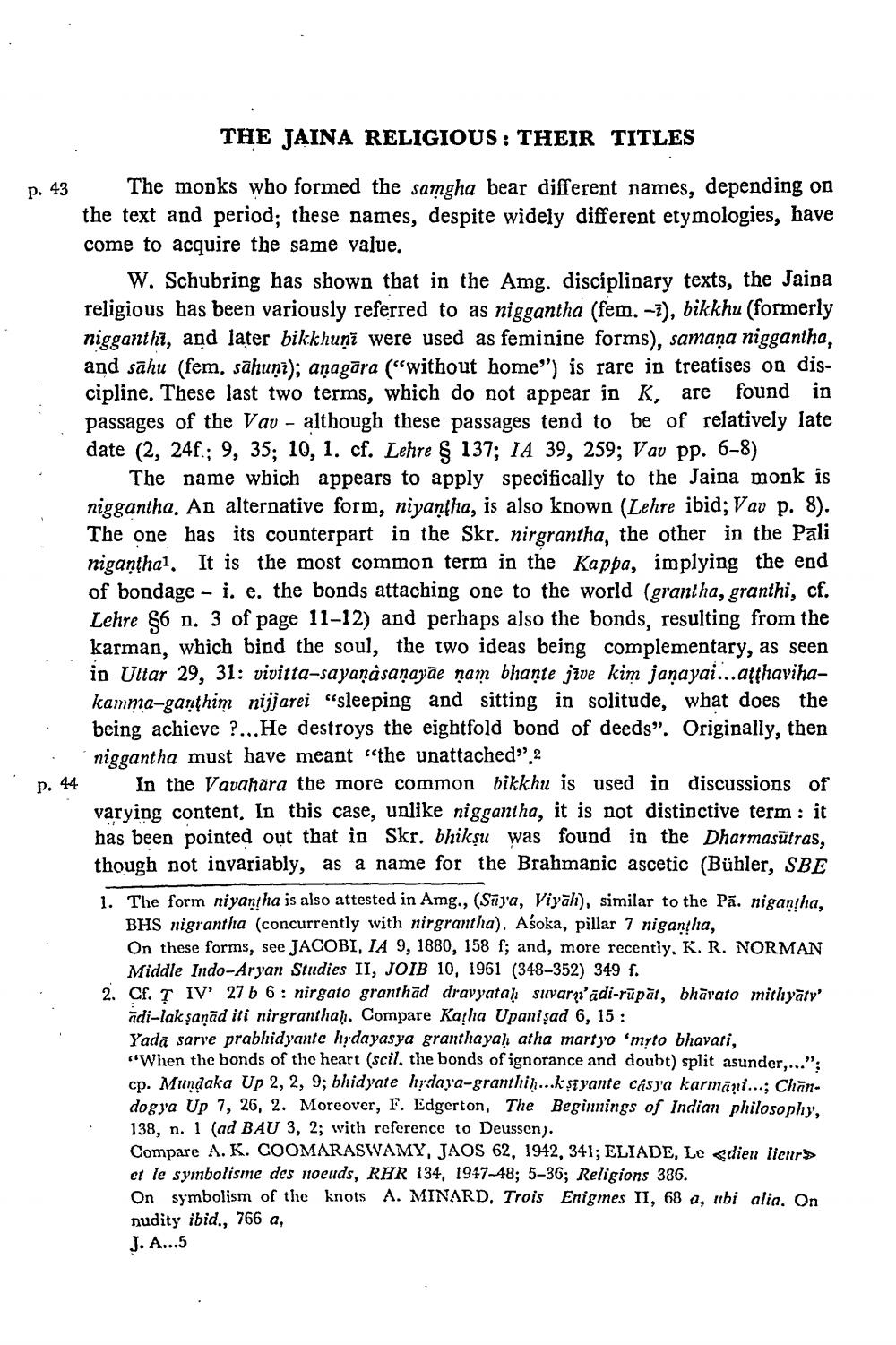________________
THE JAINA RELIGIOUS: THEIR TITLES
p. 43
The monks who formed the samgha bear different names, depending on the text and period; these names, despite widely different etymologies, have come to acquire the same value.
p. 44
W. Schubring has shown that in the Amg. disciplinary texts, the Jaina religious has been variously referred to as niggantha (fem. -7), bikkhu (formerly nigganthi, and later bikkhuni were used as feminine forms), samaṇa niggantha, and sāhu (fem, sāhuṇī); aṇagāra (“without home") is rare in treatises on discipline. These last two terms, which do not appear in K, are found in passages of the Vav although these passages tend to be of relatively late date (2, 24f; 9, 35; 10, 1. cf. Lehre § 137; IA 39, 259; Vav pp. 6-8)
-
The name which appears to apply specifically to the Jaina monk is niggantha. An alternative form, niyantha, is also known (Lehre ibid; Vav p. 8). The one has its counterpart in the Skr. nirgrantha, the other in the Pali nigantha1. It is the most common term in the Kappa, implying the end of bondage i. e. the bonds attaching one to the world (grantha, granthi, cf. Lehre §6 n. 3 of page 11-12) and perhaps also the bonds, resulting from the karman, which bind the soul, the two ideas being complementary, as seen in Uttar 29, 31: vivitta-sayaṇâsaṇayāe nam bhante jive kim janayai...aṭṭhavihakamma-ganthim nijjarei "sleeping and sitting in solitude, what does the being achieve ?...He destroys the eightfold bond of deeds". Originally, then niggantha must have meant "the unattached".2
In the Vavahara the more common bikkhu is used in discussions of varying content. In this case, unlike niggantha, it is not distinctive term: it has been pointed out that in Skr. bhiksu was found in the Dharmasūtras, though not invariably, as a name for the Brahmanic ascetic (Bühler, SBE
1. The form niyantha is also attested in Amg., (Suya, Viyah), similar to the Pa. nigantha, BHS nigrantha (concurrently with nirgrantha). Aśoka, pillar 7 nigantha,
On these forms, see JACOBI, IA 9, 1880, 158 f; and, more recently, K. R. NORMAN Middle Indo-Aryan Studies II, JOIB 10, 1961 (348-352) 349 f.
2. Cf. T IV' 27 b 6: nirgato granthad dravyataḥ suvary'ādi-rūpāt, bhāvato mithyāty' adi-lakṣaṇād iti nirgranthaḥ. Compare Katha Upaniṣad 6, 15:
Yadā sarve prabhidyante hydayasya granthayaḥ atha martyo 'mṛto bhavati,
"When the bonds of the heart (scil, the bonds of ignorance and doubt) split asunder,..."; cp. Mundaka Up 2, 2, 9; bhidyate hydaya-granthiḥ...kṣiyante câsya karmāņi...; Chāndogya Up 7, 26, 2. Moreover, F. Edgerton, The Beginnings of Indian philosophy, 138, n. 1 (ad BAU 3, 2; with reference to Deussen).
Compare A. K. COOMARASWAMY, JAOS 62, 1942, 341; ELIADE, Le dieu lieur et le symbolisme des noeuds, RHR 134, 1947-48; 5-36; Religions 386.
On symbolism of the knots A. MINARD, Trois Enigmes II, 68 a, ubi alia. On nudity ibid., 766 a,
J. A...5




